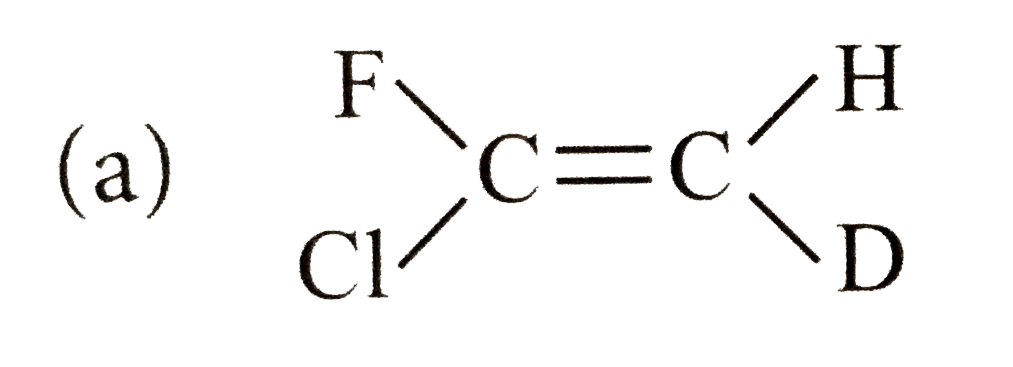Which of the following will not be able to show optical isomerism (enantiomerism)?
1,2-Propadiene
2,3-Pentadiene
sec-Butyl alcohol
All exhibit enantiomerism
The correct Answer is:A
To determine which of the given compounds will not be able to show optical isomerism (enantiomerism), we will analyze each option step by step.
Step 1: Analyze 1,2-Propadiene
1,2-Propadiene has the structure:
CH2=C=CH2
In this molecule, the terminal carbon atoms each have two hydrogen atoms attached. Therefore, there is a plane of symmetry present in the molecule. Since it contains a plane of symmetry, it cannot show optical isomerism.
Step 2: Analyze 2,3-Pentadiene
2,3-Pentadiene has the structure:
CH3−CH=C=CH−CH3
In this structure, the second and third carbon atoms have different groups attached (one has a hydrogen and the other has a methyl group). There is no plane of symmetry present in this molecule, which allows it to show optical isomerism.
Step 3: Analyze Secondary Butyl Alcohol
Secondary butyl alcohol has the structure:
CH3−CH(OH)−CH2−CH3
The second carbon (the one with the hydroxyl group) is a chiral center because it is attached to four different groups (methyl, hydroxyl, hydrogen, and ethyl). Therefore, this compound can show optical isomerism.
Conclusion
From the analysis:
- 1,2-Propadiene cannot show optical isomerism due to the presence of a plane of symmetry.
- 2,3-Pentadiene can show optical isomerism.
- Secondary butyl alcohol can show optical isomerism.
Thus, the compound that will not be able to show optical isomerism is 1,2-Propadiene.
Final Answer
The correct answer is Option 1: 1,2-Propadiene.
---
1,2-Propadiene has the structure:
CH2=C=CH2
In this molecule, the terminal carbon atoms each have two hydrogen atoms attached. Therefore, there is a plane of symmetry present in the molecule. Since it contains a plane of symmetry, it cannot show optical isomerism.
2,3-Pentadiene has the structure:
CH3−CH=C=CH−CH3
In this structure, the second and third carbon atoms have different groups attached (one has a hydrogen and the other has a methyl group). There is no plane of symmetry present in this molecule, which allows it to show optical isomerism.
Secondary butyl alcohol has the structure:
CH3−CH(OH)−CH2−CH3
The second carbon (the one with the hydroxyl group) is a chiral center because it is attached to four different groups (methyl, hydroxyl, hydrogen, and ethyl). Therefore, this compound can show optical isomerism.
From the analysis:
- 1,2-Propadiene cannot show optical isomerism due to the presence of a plane of symmetry.
- 2,3-Pentadiene can show optical isomerism.
- Secondary butyl alcohol can show optical isomerism.
The correct answer is Option 1: 1,2-Propadiene.
Topper's Solved these Questions
- ISOMERISMBOOK - CENGAGE CHEMISTRY ENGLISHCHAPTER - ISOMERISMEXERCISE - Single correct answer type (Exercise)
65 Videos
- ISOMERISMBOOK - CENGAGE CHEMISTRY ENGLISHCHAPTER - ISOMERISMEXERCISE - Assertion-Reasoning Type (Exercise)
5 Videos
- ISOMERISMBOOK - CENGAGE CHEMISTRY ENGLISHCHAPTER - ISOMERISMEXERCISE - Multiple choice questions (Exercise)
38 Videos
- IONIC EQUILIBRIUMBOOK - CENGAGE CHEMISTRY ENGLISHCHAPTER - IONIC EQUILIBRIUMEXERCISE - Archives Subjective
28 Videos
- NCERT BASED EXERCISEBOOK - CENGAGE CHEMISTRY ENGLISHCHAPTER - NCERT BASED EXERCISEEXERCISE - Chemical Equilibrium
73 Videos
Similar Questions
Knowledge Check
Which of the following will not show optical isomerism ?
ACl−CH=C=CH−ClBBr−CH=C=CH−BrC D
D
Which of the following will not show geometrical isomerism ?
A B
B C
C D
D
Which of the following will not show geometrical isomerism?
A B
B C
C D
D
Which one of the following will be able to show geometrical isomerism if complexes are square planar? .
View SolutionWhich of the following will not show geometrical isomerism ?
View SolutionWhich of the following will not show geometrical isomerism?
View SolutionWhich of the following will not show geometrical isomerism?
View SolutionWhich of the following will not show geometrical isomerism ?
View Solution
